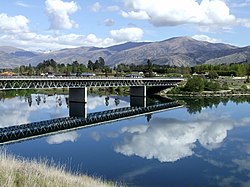This article needs additional citations for verification .(July 2015) |
| State Highway 8 | ||||
|---|---|---|---|---|
 | ||||
| Route information | ||||
| Maintained by NZ Transport Agency Waka Kotahi | ||||
| Length | 457 km (284 mi) | |||
| Major junctions | ||||
| North (clockwise) end | ||||
| South (anticlockwise) end | ||||
| Location | ||||
| Country | New Zealand | |||
| Primary destinations | Pleasant Point, Fairlie, Lake Tekapo, Twizel, Omarama, Cromwell, Clyde, Alexandra, Roxburgh, Lawrence | |||
| Highway system | ||||
| ||||
State Highway 8 is one of New Zealand's eight national highways. It forms an anticlockwise loop through the southern scenic regions of the Mackenzie Basin and Central Otago, starting and terminating in junctions with State Highway 1. Distances are measured from north to south.
Contents
- Route
- Main route
- Spur sections
- Route changes
- History
- Statistics
- Major intersections
- References
- External links
For most of its length SH8 is a two-lane single carriageway, with at-grade intersections and property accesses directly off the road, both in rural and urban areas.



